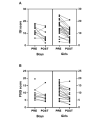Gender Differences in Adolescent Sleep Disturbance and Treatment Response to Smartphone App-Delivered Cognitive Behavioral Therapy for Insomnia: Exploratory Study
- PMID: 33755029
- PMCID: PMC8075040
- DOI: 10.2196/22498
Gender Differences in Adolescent Sleep Disturbance and Treatment Response to Smartphone App-Delivered Cognitive Behavioral Therapy for Insomnia: Exploratory Study
Abstract
Background: Insomnia and sleep disturbance are pervasive and debilitating conditions affecting up to 40% of adolescents. Women and girls are at greater risk of insomnia, yet differences in treatment responsiveness between genders have not been adequately investigated. Additionally, while women report greater symptom severity and burden of illness than men, this discrepancy requires further examination in adolescents.
Objective: The purpose of this study was to examine gender differences in sleep symptom profiles and treatment response in adolescents.
Methods: Digital cognitive behavioral therapy for insomnia (CBT-I) treatment responsiveness, as indexed by changes in Insomnia Severity Index (ISI) and Global Pittsburgh Sleep Quality Index (PSQI) scores, was compared in boys and girls (aged 12-16 years; N=49) who participated in a pilot evaluation of the Sleep Ninja smartphone app. Gender differences in self-reported baseline insomnia symptom severity (ISI), sleep quality (PSQI), and sleep characteristics derived from sleep diaries were also examined.
Results: Compared with boys, we found that girls reported greater symptom severity (P=.04) and nighttime wakefulness (P=.01 and P=.04) and reduced sleep duration (P=.02) and efficiency (P=.03), but not poorer sleep quality (P=.07), more nighttime awakenings (P=.16), or longer time to get to sleep (P=.21). However, gender differences in symptom severity and sleep duration were accounted for by boys being marginally younger in age. Treatment response to CBT-I was equivalent between boys and girls when comparing reductions in symptom severity (P=.32); there was a trend showing gender differences in improvements in sleep quality, but this was not statistically significant (P=.07).
Conclusions: These results demonstrate the presence of gender differences in insomnia symptoms and severity in adolescents and suggest further research is required to understand gender differences in insomnia symptom profiles to inform the development of gender-specific digital interventions delivered to adolescents.
Keywords: adolescents; digital interventions; gender; gender differences; insomnia; sleep; sleep disturbance; sleep quality.
©Sophie H Li, Bronwyn M Graham, Aliza Werner-Seidler. Originally published in JMIR Formative Research (http://formative.jmir.org), 23.03.2021.
Conflict of interest statement
Conflicts of Interest: None declared.
Figures
Similar articles
-
Are the Insomnia Severity Index and Pittsburgh Sleep Quality Index valid outcome measures for Cognitive Behavioral Therapy for Insomnia? Inquiry from the perspective of response shifts and longitudinal measurement invariance in their Chinese versions.Sleep Med. 2017 Jul;35:35-40. doi: 10.1016/j.sleep.2017.04.003. Epub 2017 Apr 30. Sleep Med. 2017. PMID: 28619180
-
Analysis of the Improvement Sequence in Insomnia Symptoms and Factors Influencing the Treatment Outcomes of Smartphone-Delivered CBT in Patients with Insomnia Disorder.Nat Sci Sleep. 2024 Sep 13;16:1365-1376. doi: 10.2147/NSS.S486288. eCollection 2024. Nat Sci Sleep. 2024. PMID: 39290809 Free PMC article.
-
Digital Cognitive Behavioral Therapy for Insomnia for Adolescents With Mental Health Problems: Feasibility Open Trial.JMIR Ment Health. 2020 Mar 3;7(3):e14842. doi: 10.2196/14842. JMIR Ment Health. 2020. PMID: 32134720 Free PMC article.
-
Psychological treatment for insomnia in the regulation of long-term hypnotic drug use.Health Technol Assess. 2004 Feb;8(8):iii-iv, 1-68. doi: 10.3310/hta8080. Health Technol Assess. 2004. PMID: 14960254 Review.
-
Insomnia Disorder: Gender Issues Over the Lifespan.J Sleep Res. 2025 Jun 3:e70110. doi: 10.1111/jsr.70110. Online ahead of print. J Sleep Res. 2025. PMID: 40461101 Review.
Cited by
-
Factoring and correlation in sleep, fatigue and mental workload of clinical first-line nurses in the post-pandemic era of COVID-19: A multi-center cross-sectional study.Front Psychiatry. 2022 Aug 25;13:963419. doi: 10.3389/fpsyt.2022.963419. eCollection 2022. Front Psychiatry. 2022. PMID: 36090368 Free PMC article.
-
Association between Beverage Consumption and Sleep Quality in Adolescents.Nutrients. 2024 Jan 18;16(2):285. doi: 10.3390/nu16020285. Nutrients. 2024. PMID: 38257178 Free PMC article.
-
Nightmare Distress as a Risk Factor for Suicide Among Adolescents with Major Depressive Disorder.Nat Sci Sleep. 2022 Sep 22;14:1687-1697. doi: 10.2147/NSS.S362999. eCollection 2022. Nat Sci Sleep. 2022. PMID: 36172081 Free PMC article.
-
The Task Pre-Configuration Is Associated With Cognitive Performance Evidence From the Brain Synchrony.Front Comput Neurosci. 2022 May 6;16:883660. doi: 10.3389/fncom.2022.883660. eCollection 2022. Front Comput Neurosci. 2022. PMID: 35603133 Free PMC article.
-
Relationship between Smartphone Addiction and Sleep Satisfaction: A Cross-Sectional Study on Korean Adolescents.Healthcare (Basel). 2022 Jul 17;10(7):1326. doi: 10.3390/healthcare10071326. Healthcare (Basel). 2022. PMID: 35885851 Free PMC article.
References
-
- Carskadon MA. Patterns of sleep and sleepiness in adolescents. Pediatrician. 1990;17(1):5–12. - PubMed
LinkOut - more resources
Full Text Sources
Other Literature Sources


